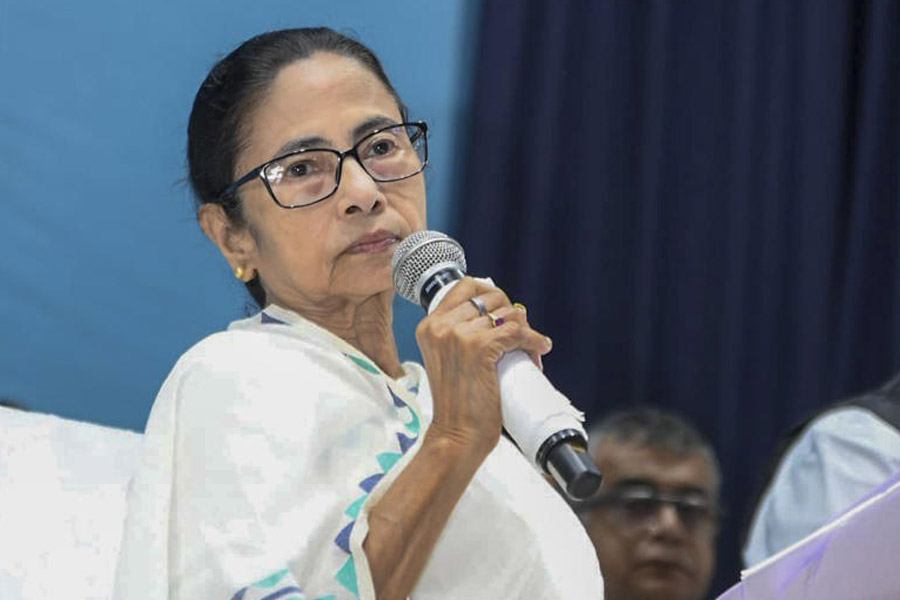 |
 |
| Painting of “Buri” by Gaganendranath Tagore (top) and his painting of the arch |
While painting during our stay at the Balihar lodge in Ranchi I saw him repeatedly gazing up at the portico arch and concluded he was drawing the scenery, but when he had finished I saw that only the arch was recognisable. The scene beyond the arch was from imagination — a lonely boat on a wide river merging with the sky, distant hills and forests. That was my father’s last painting,” writes Purnima Devi (Chattopadhyay nee Tagore) about her father Gaganendranath Tagore in a book to be published shortly.
The book contains excerpts from her writing and numerous old family photographs, reproductions of Gaganendranath’s paintings and cartoons and memorabilia dating from the time of Prince Dwarkanath Tagore.
At 85, Purnima Devi holds many keys to the past. Take for instance the mystery surrounding Dwarkanath’s death at sea.
According to Purnima Devi, Gaganendranath had told her that Queen Victoria was very fond of Dwarkanath, whom she had given the title of Prince.
She used to play chess with him and had made him governor of Bihar, Bengal and Orissa. This decision had made many unhappy. So while Dwarkanath was on his way back to India, someone laced his food with poison.
On receiving the news of his death, the Queen was most upset and said that his body was to be brought back quickly to England and he should be laid to rest close to where she would be buried.
“I haven’t been able to verify if his body was really buried there but this is one of the family’s closely guarded secrets,” says Partha Chattopadhyay, Purnima Devi’s son, who is publishing the book from Sahitya Bharati Publications.
 |
| A contestant at a dog show organised by the North Calcutta Kennel Club at Deshabandhu Park on Friday. Picture by Bishwarup Dutta |
Partha has not only sifted through family collections and other sources to make the book as conclusive as possible but has also taken down dictation of some of the later sections of the writing when Purnima Devi fell ill.
Many less sensational details bring the Tagore family alive. There are descriptions of inner chambers, of family celebrations and mournings, shot through with a girl’s admiration of a father who was humble, broad-minded and fun. Purnima, “Buri” to her father, felt he could touch everything with magic.
It was Gaganendranath or GT (as he signed) who designed Tagore’s trademark cap and robe. He began painting long after his brother Abanindranath but loved fashioning dresses and jewellery.
He created a Japanese garden and redesigned all the furniture in keeping with the Swadeshi sentiments. GT not only acted in plays like Dakghar and Bisarjan, he also designed most of Tagore’s theatre costumes and sets. A large pencil sketch for the set decoration of Natir Puja is with Partha. So are numerous letters, a writing desk, pens and colours used by the artist, jewellery designed by him, shoes, clothes and a camera. Other items mentioned in the book include the family crest given to Dwarkanath by Queen Victoria, Dwarkanath’s pipe and a tiny ivory elephant gifted by the Japanese artist Okakura to GT.
But the book is also valuable as a compilation of most of Gaganendranath’s cartoons from socially critical booklets like Reform Screams, a pictorial review at the close of the year 1921, Nava Hullor and Birup Bajra. Unlike his paintings, the cartoons show a mind reacting sharply to daily realities and the foibles of man.
Take the Automatic Speech-making Machine that can churn out memorial speeches, self-government speeches, Congress speeches, religious speeches and silly speeches at the click of a button.
Then there is the University Machine where individuals are crammed with knowledge and pressed into faceless cut-out figures.
 |
Same fare
The city was introduced to Indigo cabs some time ago, smart cars that possibly look so snazzy to Calcuttans that they feel inhibited. Not many dare to climb into them, thinking they are more expensive than the yellow Amby cab, though the words “Same fare” are displayed boldly on the bodies of the new cabs.
So an Indigo cab driver, parked near a Central Calcutta Metro station, decided to take matters in his own hands. Since the written word wasn’t enough, he began to hawk his cab. “Didi, eta shotyi same fare, Dada, eta shotyi same fare,” he cried, till a middle-aged woman was convinced and stepped into his vehicle.










